coolant temperature RENAULT SCENIC 2012 J95 / 3.G Engine And Peripherals EDC16CP33 Workshop Manual
[x] Cancel search | Manufacturer: RENAULT, Model Year: 2012, Model line: SCENIC, Model: RENAULT SCENIC 2012 J95 / 3.GPages: 510, PDF Size: 2.98 MB
Page 418 of 510
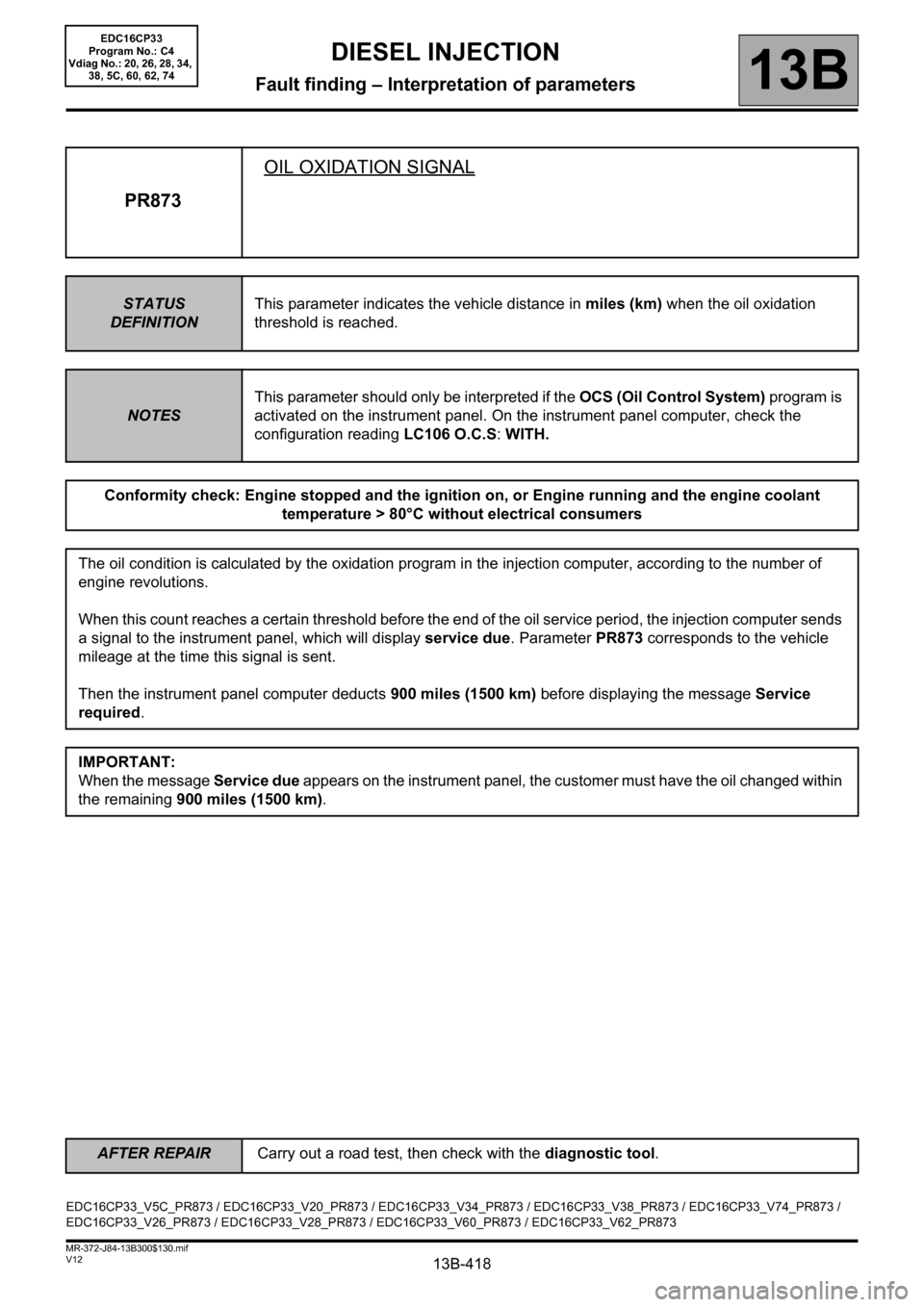
13B-418
AFTER REPAIRCarry out a road test, then check with the diagnostic tool.
V12 MR-372-J84-13B300$130.mif
13B
PR873OIL OXIDATION SIGNAL
STATUS
DEFINITIONThis parameter indicates the vehicle distance in miles (km) when the oil oxidation
threshold is reached.
NOTESThis parameter should only be interpreted if the OCS (Oil Control System) program is
activated on the instrument panel. On the instrument panel computer, check the
configuration reading LC106 O.C.S: WITH.
Conformity check: Engine stopped and the ignition on, or Engine running and the engine coolant
temperature > 80°C without electrical consumers
The oil condition is calculated by the oxidation program in the injection computer, according to the number of
engine revolutions.
When this count reaches a certain threshold before the end of the oil service period, the injection computer sends
a signal to the instrument panel, which will display service due. Parameter PR873 corresponds to the vehicle
mileage at the time this signal is sent.
Then the instrument panel computer deducts 900 miles (1500 km) before displaying the message Service
required.
IMPORTANT:
When the message Service due appears on the instrument panel, the customer must have the oil changed within
the remaining 900 miles (1500 km).
EDC16CP33_V5C_PR873 / EDC16CP33_V20_PR873 / EDC16CP33_V34_PR873 / EDC16CP33_V38_PR873 / EDC16CP33_V74_PR873 /
EDC16CP33_V26_PR873 / EDC16CP33_V28_PR873 / EDC16CP33_V60_PR873 / EDC16CP33_V62_PR873
DIESEL INJECTION
Fault finding – Interpretation of parameters
EDC16CP33
Program No.: C4
Vdiag No.: 20, 26, 28, 34,
38, 5C, 60, 62, 74
Page 420 of 510
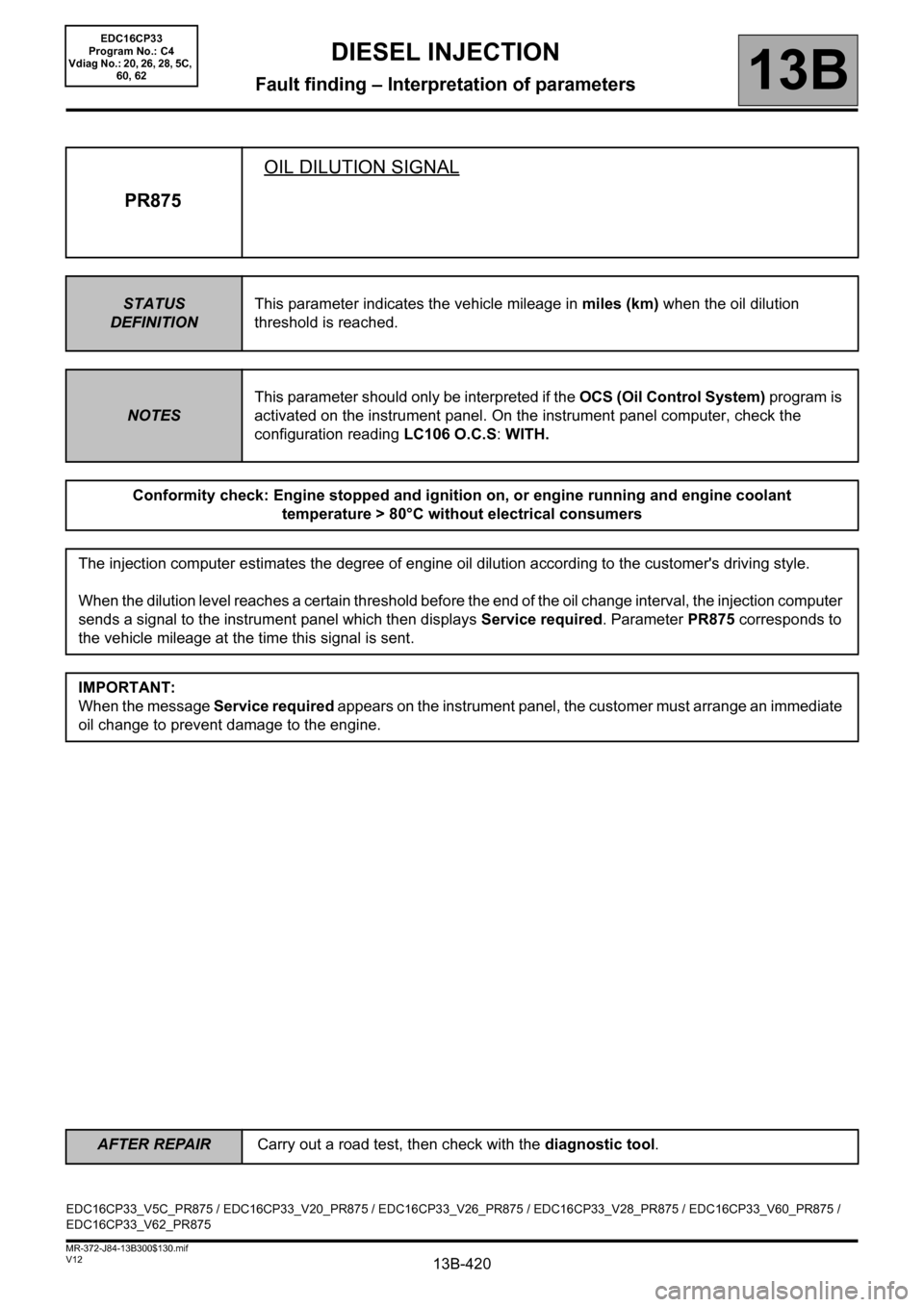
13B-420
AFTER REPAIRCarry out a road test, then check with the diagnostic tool.
V12 MR-372-J84-13B300$130.mif
DIESEL INJECTION
Fault finding – Interpretation of parameters13B
PR875OIL DILUTION SIGNAL
STATUS
DEFINITIONThis parameter indicates the vehicle mileage in miles (km) when the oil dilution
threshold is reached.
NOTESThis parameter should only be interpreted if the OCS (Oil Control System) program is
activated on the instrument panel. On the instrument panel computer, check the
configuration reading LC106 O.C.S: WITH.
Conformity check: Engine stopped and ignition on, or engine running and engine coolant
temperature > 80°C without electrical consumers
The injection computer estimates the degree of engine oil dilution according to the customer's driving style.
When the dilution level reaches a certain threshold before the end of the oil change interval, the injection computer
sends a signal to the instrument panel which then displays Service required. Parameter PR875 corresponds to
the vehicle mileage at the time this signal is sent.
IMPORTANT:
When the message Service required appears on the instrument panel, the customer must arrange an immediate
oil change to prevent damage to the engine.
EDC16CP33_V5C_PR875 / EDC16CP33_V20_PR875 / EDC16CP33_V26_PR875 / EDC16CP33_V28_PR875 / EDC16CP33_V60_PR875 /
EDC16CP33_V62_PR875
EDC16CP33
Program No.: C4
Vdiag No.: 20, 26, 28, 5C,
60, 62
Page 421 of 510
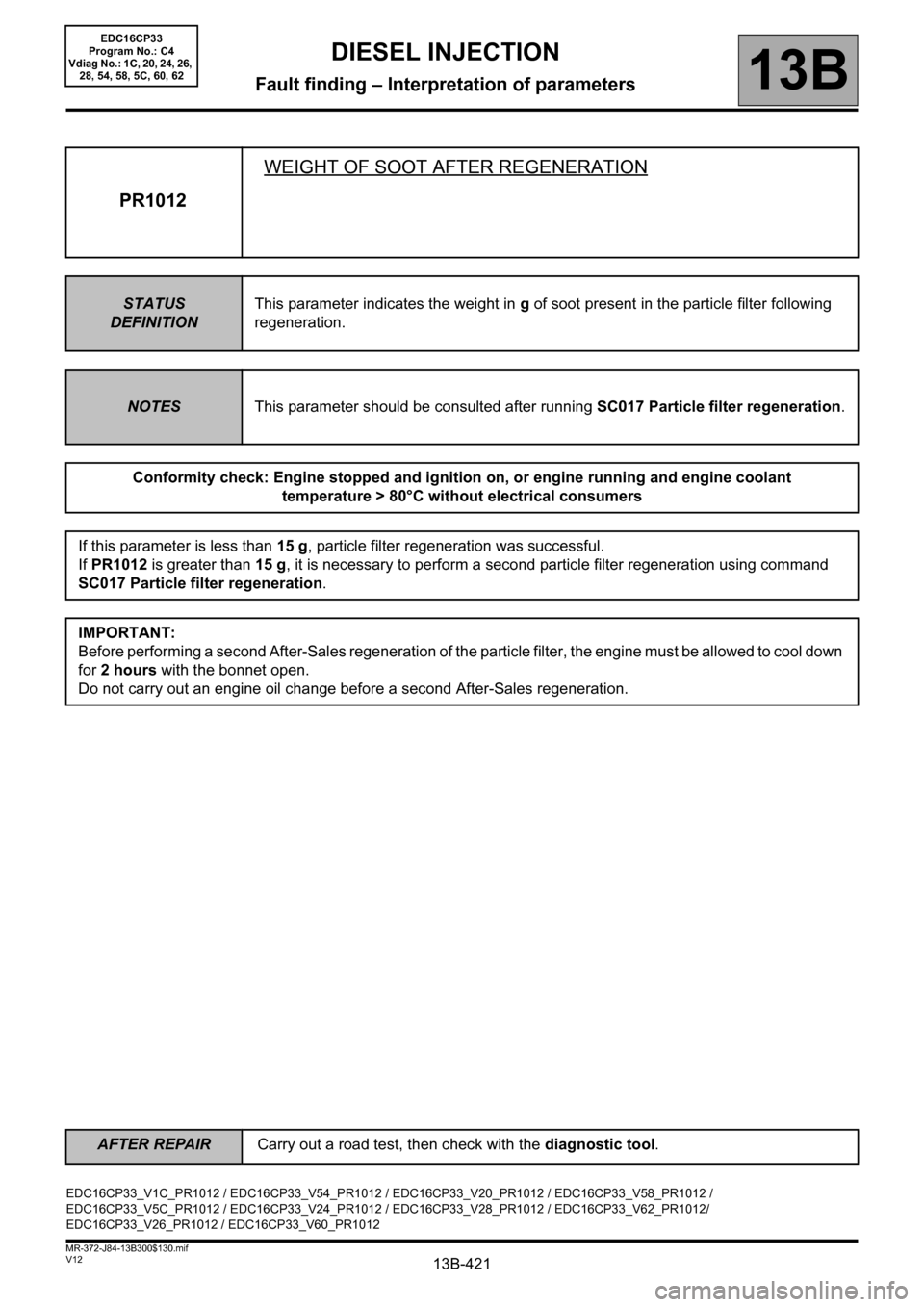
13B-421
AFTER REPAIRCarry out a road test, then check with the diagnostic tool.
V12 MR-372-J84-13B300$130.mif
DIESEL INJECTION
Fault finding – Interpretation of parameters13B
PR1012WEIGHT OF SOOT AFTER REGENERATION
STATUS
DEFINITIONThis parameter indicates the weight in g of soot present in the particle filter following
regeneration.
NOTESThis parameter should be consulted after running SC017 Particle filter regeneration.
Conformity check: Engine stopped and ignition on, or engine running and engine coolant
temperature > 80°C without electrical consumers
If this parameter is less than 15 g, particle filter regeneration was successful.
If PR1012 is greater than 15 g, it is necessary to perform a second particle filter regeneration using command
SC017 Particle filter regeneration.
IMPORTANT:
Before performing a second After-Sales regeneration of the particle filter, the engine must be allowed to cool down
for 2 hours with the bonnet open.
Do not carry out an engine oil change before a second After-Sales regeneration.
EDC16CP33_V1C_PR1012 / EDC16CP33_V54_PR1012 / EDC16CP33_V20_PR1012 / EDC16CP33_V58_PR1012 /
EDC16CP33_V5C_PR1012 / EDC16CP33_V24_PR1012 / EDC16CP33_V28_PR1012 / EDC16CP33_V62_PR1012/
EDC16CP33_V26_PR1012 / EDC16CP33_V60_PR1012
EDC16CP33
Program No.: C4
Vdiag No.: 1C, 20, 24, 26,
28, 54, 58, 5C, 60, 62
Page 428 of 510
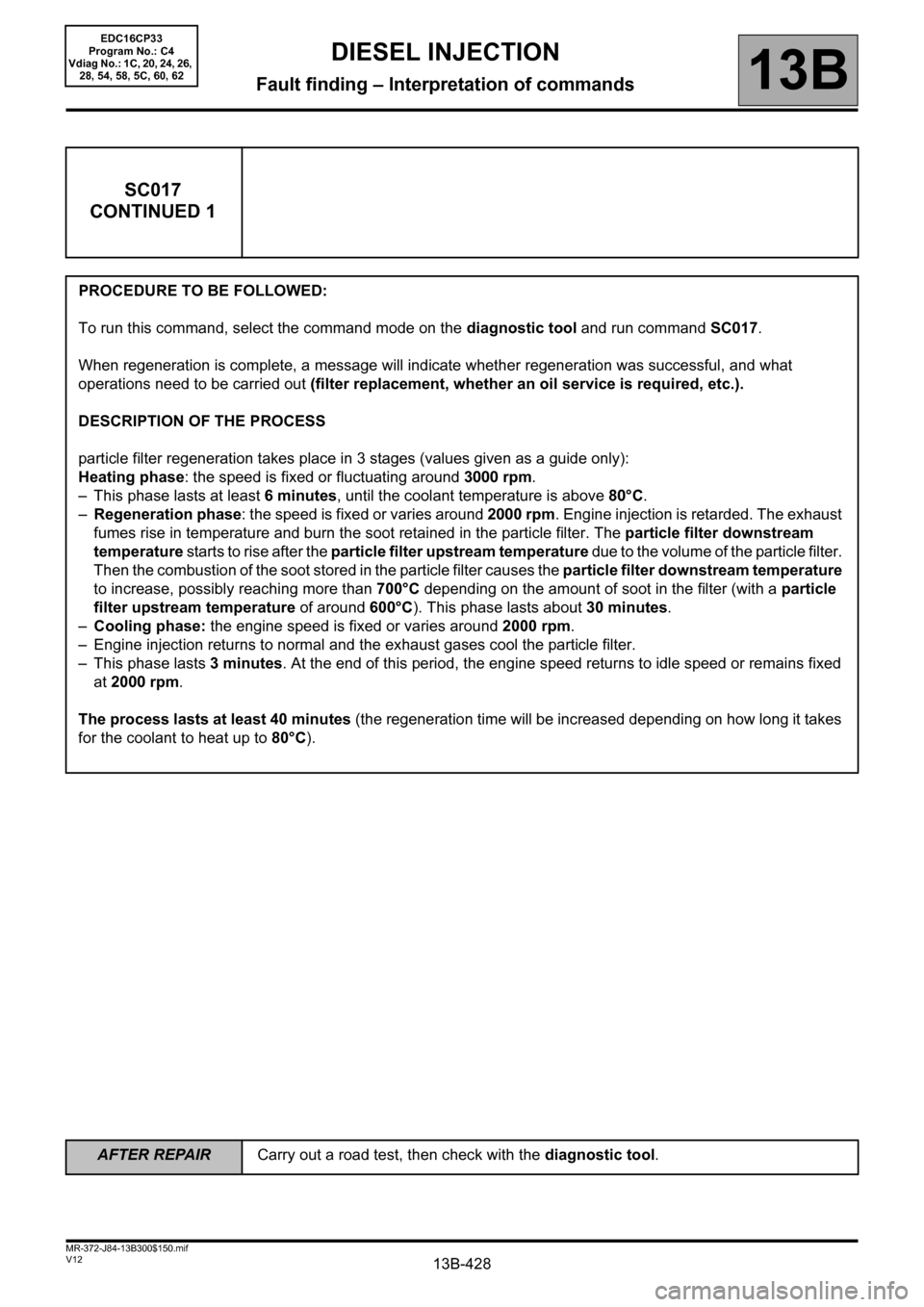
13B-428V12 MR-372-J84-13B300$150.mif
DIESEL INJECTION
Fault finding – Interpretation of commands13B
SC017
CONTINUED 1
PROCEDURE TO BE FOLLOWED:
To run this command, select the command mode on the diagnostic tool and run command SC017.
When regeneration is complete, a message will indicate whether regeneration was successful, and what
operations need to be carried out (filter replacement, whether an oil service is required, etc.).
DESCRIPTION OF THE PROCESS
particle filter regeneration takes place in 3 stages (values given as a guide only):
Heating phase: the speed is fixed or fluctuating around 3000 rpm.
– This phase lasts at least 6minutes, until the coolant temperature is above 80°C.
–Regeneration phase: the speed is fixed or varies around 2000 rpm. Engine injection is retarded. The exhaust
fumes rise in temperature and burn the soot retained in the particle filter. The particle filter downstream
temperature starts to rise after the particle filter upstream temperature due to the volume of the particle filter.
Then the combustion of the soot stored in the particle filter causes the particle filter downstream temperature
to increase, possibly reaching more than 700°C depending on the amount of soot in the filter (with a particle
filter upstream temperature of around 600°C). This phase lasts about 30 minutes.
–Cooling phase: the engine speed is fixed or varies around 2000 rpm.
– Engine injection returns to normal and the exhaust gases cool the particle filter.
– This phase lasts 3 minutes. At the end of this period, the engine speed returns to idle speed or remains fixed
at 2000 rpm.
The process lasts at least 40 minutes (the regeneration time will be increased depending on how long it takes
for the coolant to heat up to 80°C).
EDC16CP33
Program No.: C4
Vdiag No.: 1C, 20, 24, 26,
28, 54, 58, 5C, 60, 62
AFTER REPAIRCarry out a road test, then check with the diagnostic tool.
Page 459 of 510
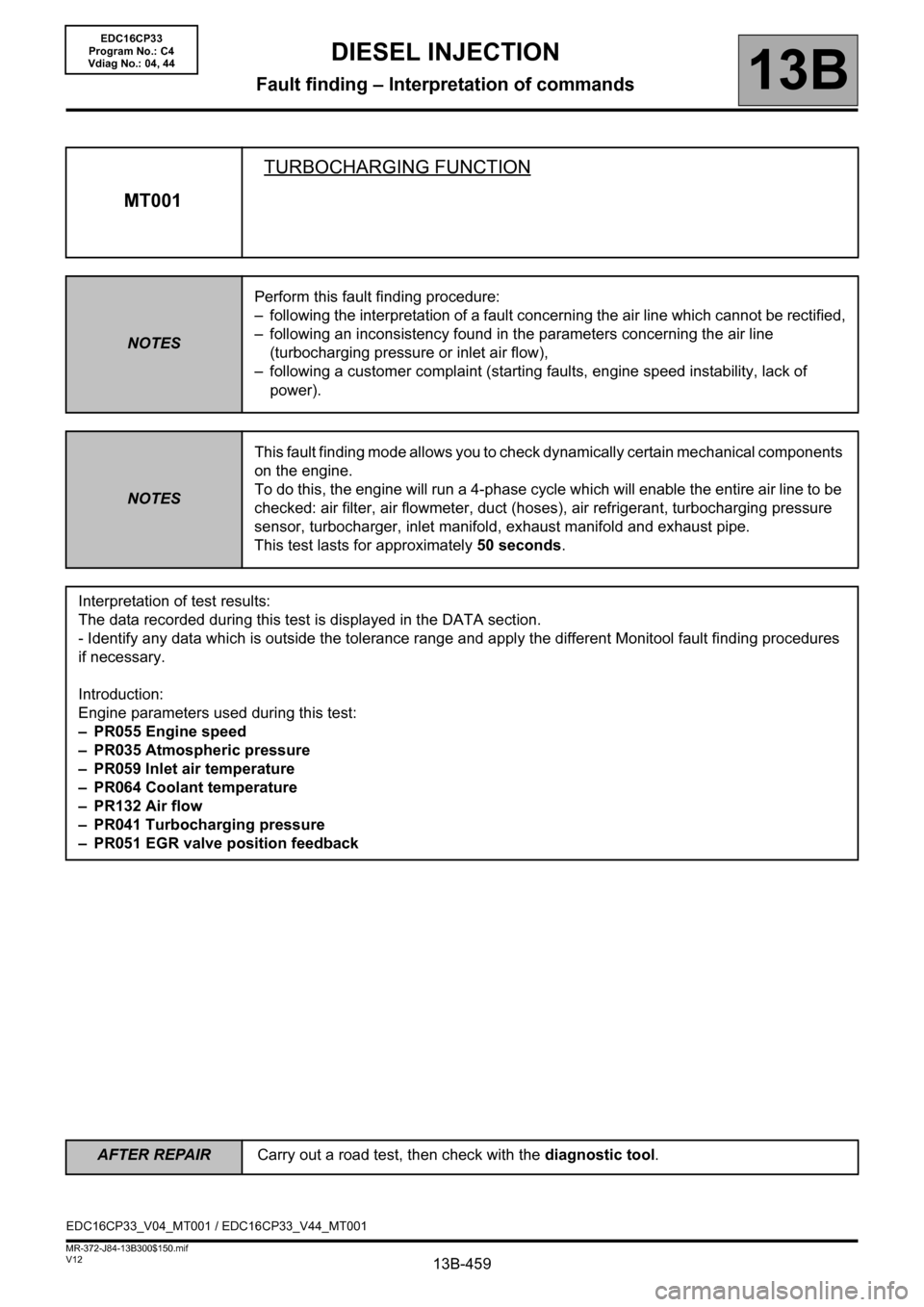
13B-459V12 MR-372-J84-13B300$150.mif
DIESEL INJECTION
Fault finding – Interpretation of commands13B
MT001TURBOCHARGING FUNCTION
NOTESPerform this fault finding procedure:
– following the interpretation of a fault concerning the air line which cannot be rectified,
– following an inconsistency found in the parameters concerning the air line
(turbocharging pressure or inlet air flow),
– following a customer complaint (starting faults, engine speed instability, lack of
power).
NOTESThis fault finding mode allows you to check dynamically certain mechanical components
on the engine.
To do this, the engine will run a 4-phase cycle which will enable the entire air line to be
checked: air filter, air flowmeter, duct (hoses), air refrigerant, turbocharging pressure
sensor, turbocharger, inlet manifold, exhaust manifold and exhaust pipe.
This test lasts for approximately 50 seconds.
Interpretation of test results:
The data recorded during this test is displayed in the DATA section.
- Identify any data which is outside the tolerance range and apply the different Monitool fault finding procedures
if necessary.
Introduction:
Engine parameters used during this test:
– PR055 Engine speed
– PR035 Atmospheric pressure
– PR059 Inlet air temperature
– PR064 Coolant temperature
–PR132 Air flow
– PR041 Turbocharging pressure
– PR051 EGR valve position feedback
EDC16CP33_V04_MT001 / EDC16CP33_V44_MT001
EDC16CP33
Program No.: C4
Vdiag No.: 04, 44
AFTER REPAIRCarry out a road test, then check with the diagnostic tool.
Page 461 of 510
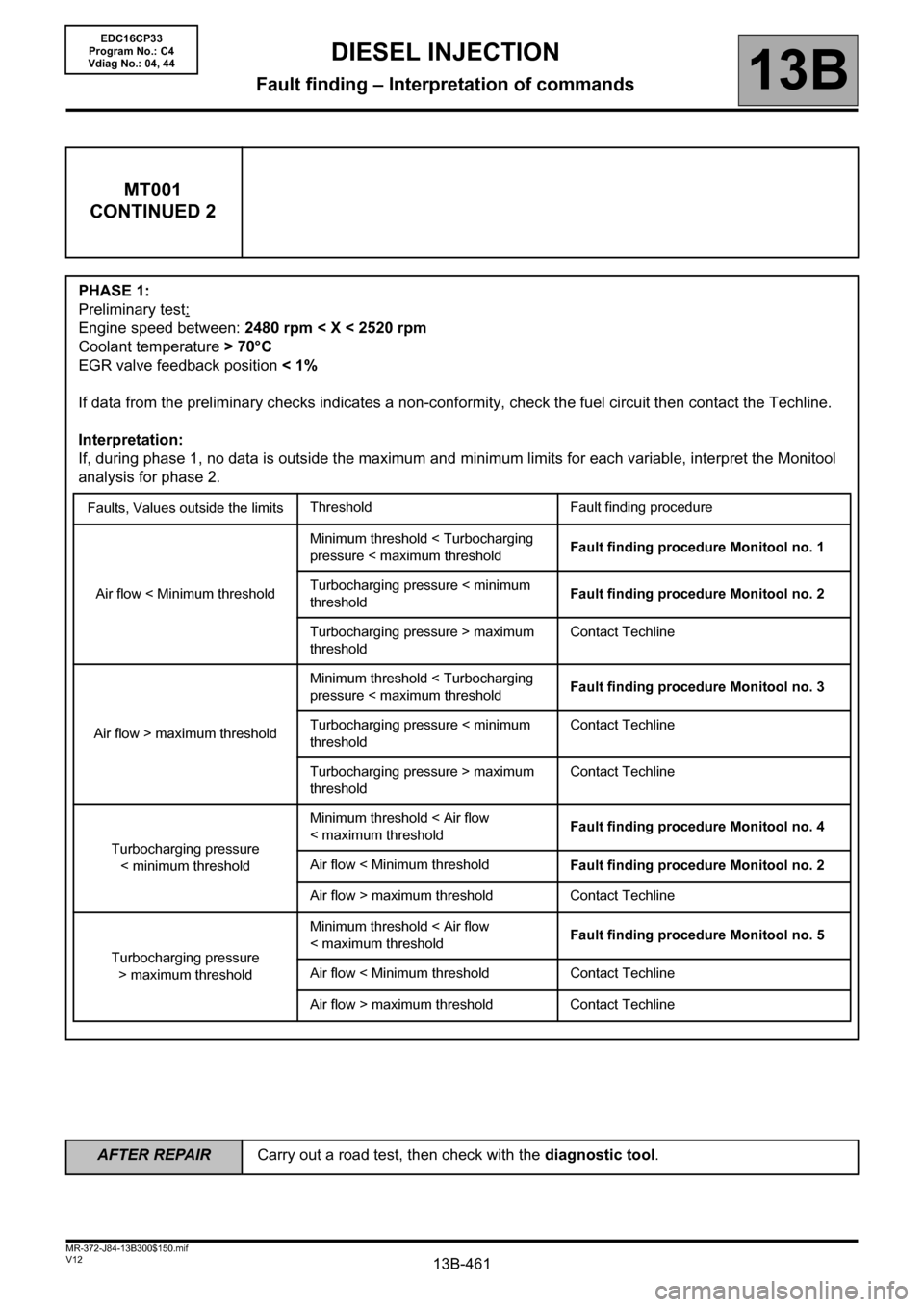
13B-461V12 MR-372-J84-13B300$150.mif
DIESEL INJECTION
Fault finding – Interpretation of commands13B
MT001
CONTINUED 2
PHASE 1:
Preliminary test:
Engine speed between: 2480 rpm < X < 2520 rpm
Coolant temperature > 70°C
EGR valve feedback position < 1%
If data from the preliminary checks indicates a non-conformity, check the fuel circuit then contact the Techline.
Interpretation:
If, during phase 1, no data is outside the maximum and minimum limits for each variable, interpret the Monitool
analysis for phase 2.
Faults, Values outside the limitsThreshold Fault finding procedure
Air flow < Minimum thresholdMinimum threshold < Turbocharging
pressure < maximum thresholdFault finding procedure Monitool no. 1
Turbocharging pressure < minimum
thresholdFault finding procedure Monitool no. 2
Turbocharging pressure > maximum
thresholdContact Techline
Air flow > maximum thresholdMinimum threshold < Turbocharging
pressure < maximum thresholdFault finding procedure Monitool no. 3
Turbocharging pressure < minimum
thresholdContact Techline
Turbocharging pressure > maximum
thresholdContact Techline
Turbocharging pressure
< minimum thresholdMinimum threshold < Air flow
< maximum thresholdFault finding procedure Monitool no. 4
Air flow < Minimum threshold
Fault finding procedure Monitool no. 2
Air flow > maximum threshold Contact Techline
Turbocharging pressure
> maximum thresholdMinimum threshold < Air flow
< maximum thresholdFault finding procedure Monitool no. 5
Air flow < Minimum threshold Contact Techline
Air flow > maximum threshold Contact Techline
EDC16CP33
Program No.: C4
Vdiag No.: 04, 44
AFTER REPAIRCarry out a road test, then check with the diagnostic tool.
Page 464 of 510
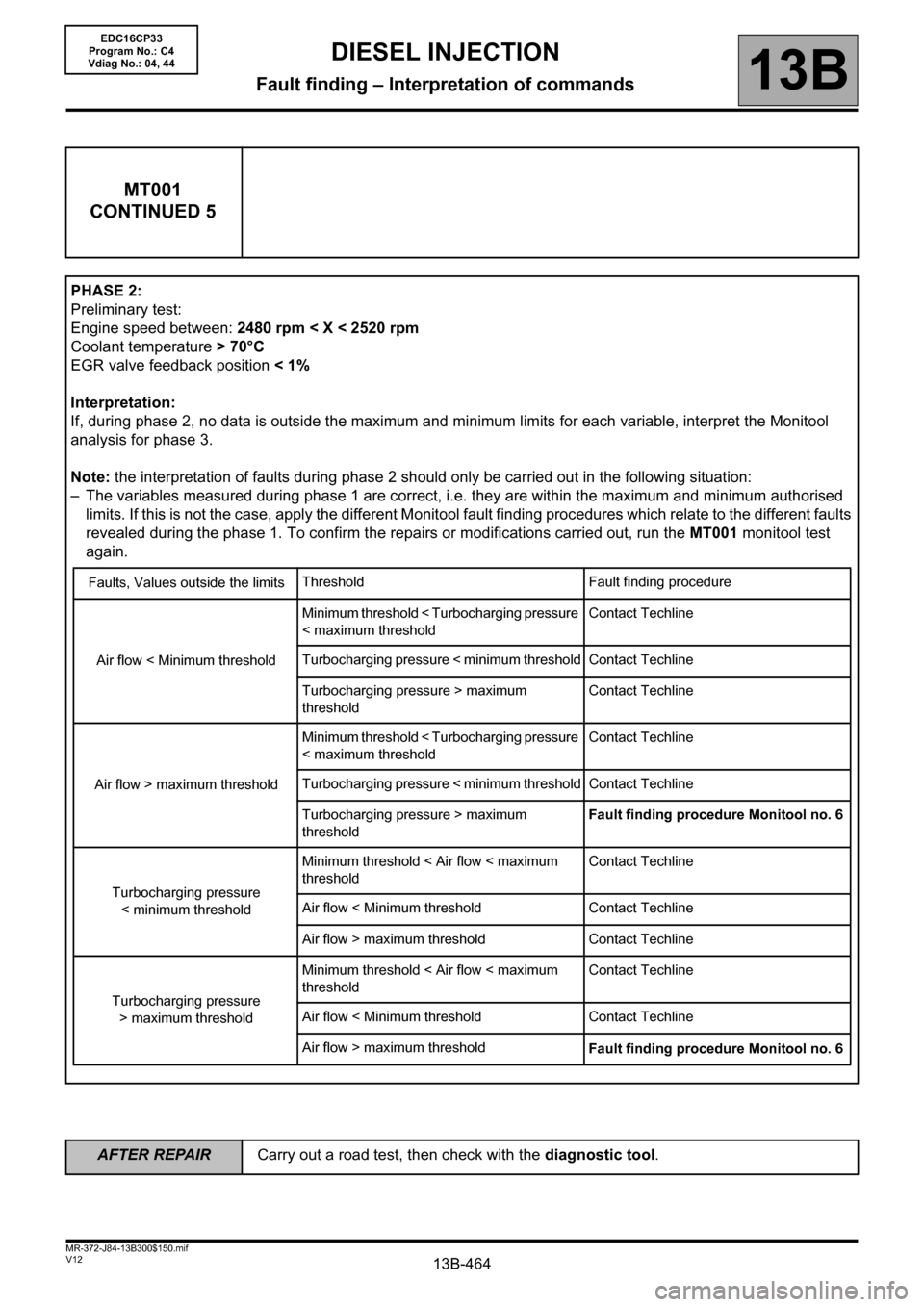
13B-464V12 MR-372-J84-13B300$150.mif
DIESEL INJECTION
Fault finding – Interpretation of commands13B
MT001
CONTINUED 5
PHASE 2:
Preliminary test:
Engine speed between: 2480 rpm < X < 2520 rpm
Coolant temperature > 70°C
EGR valve feedback position < 1%
Interpretation:
If, during phase 2, no data is outside the maximum and minimum limits for each variable, interpret the Monitool
analysis for phase 3.
Note: the interpretation of faults during phase 2 should only be carried out in the following situation:
– The variables measured during phase 1 are correct, i.e. they are within the maximum and minimum authorised
limits. If this is not the case, apply the different Monitool fault finding procedures which relate to the different faults
revealed during the phase 1. To confirm the repairs or modifications carried out, run the MT001 monitool test
again.
Faults, Values outside the limitsThreshold Fault finding procedure
Air flow < Minimum thresholdMinimum threshold < Turbocharging pressure
< maximum thresholdContact Techline
Turbocharging pressure < minimum threshold Contact Techline
Turbocharging pressure > maximum
thresholdContact Techline
Air flow > maximum thresholdMinimum threshold < Turbocharging pressure
< maximum thresholdContact Techline
Turbocharging pressure < minimum threshold Contact Techline
Turbocharging pressure > maximum
thresholdFault finding procedure Monitool no. 6
Turbocharging pressure
< minimum thresholdMinimum threshold < Air flow < maximum
thresholdContact Techline
Air flow < Minimum threshold Contact Techline
Air flow > maximum threshold Contact Techline
Turbocharging pressure
> maximum thresholdMinimum threshold < Air flow < maximum
thresholdContact Techline
Air flow < Minimum threshold Contact Techline
Air flow > maximum threshold
Fault finding procedure Monitool no. 6
EDC16CP33
Program No.: C4
Vdiag No.: 04, 44
AFTER REPAIRCarry out a road test, then check with the diagnostic tool.
Page 466 of 510
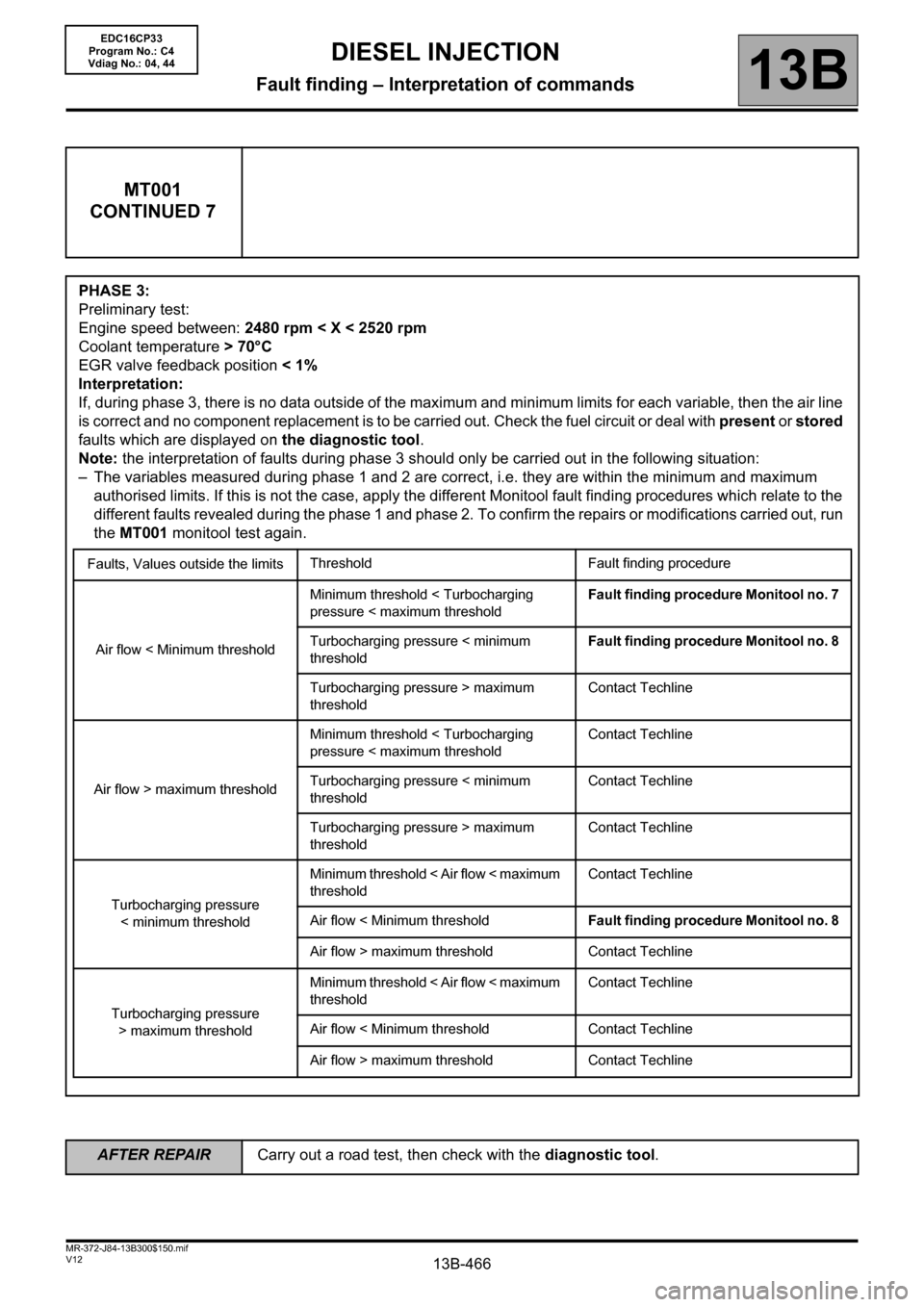
13B-466V12 MR-372-J84-13B300$150.mif
DIESEL INJECTION
Fault finding – Interpretation of commands13B
MT001
CONTINUED 7
PHASE 3:
Preliminary test:
Engine speed between: 2480 rpm < X < 2520 rpm
Coolant temperature > 70°C
EGR valve feedback position < 1%
Interpretation:
If, during phase 3, there is no data outside of the maximum and minimum limits for each variable, then the air line
is correct and no component replacement is to be carried out. Check the fuel circuit or deal with present or stored
faults which are displayed on the diagnostic tool.
Note: the interpretation of faults during phase 3 should only be carried out in the following situation:
– The variables measured during phase 1 and 2 are correct, i.e. they are within the minimum and maximum
authorised limits. If this is not the case, apply the different Monitool fault finding procedures which relate to the
different faults revealed during the phase 1 and phase 2. To confirm the repairs or modifications carried out, run
the MT001 monitool test again.
Faults, Values outside the limitsThreshold Fault finding procedure
Air flow < Minimum thresholdMinimum threshold < Turbocharging
pressure < maximum thresholdFault finding procedure Monitool no. 7
Turbocharging pressure < minimum
thresholdFault finding procedure Monitool no. 8
Turbocharging pressure > maximum
thresholdContact Techline
Air flow > maximum thresholdMinimum threshold < Turbocharging
pressure < maximum thresholdContact Techline
Turbocharging pressure < minimum
thresholdContact Techline
Turbocharging pressure > maximum
thresholdContact Techline
Turbocharging pressure
< minimum thresholdMinimum threshold < Air flow < maximum
thresholdContact Techline
Air flow < Minimum thresholdFault finding procedure Monitool no. 8
Air flow > maximum threshold Contact Techline
Turbocharging pressure
> maximum thresholdMinimum threshold < Air flow < maximum
thresholdContact Techline
Air flow < Minimum threshold Contact Techline
Air flow > maximum threshold Contact Techline
EDC16CP33
Program No.: C4
Vdiag No.: 04, 44
AFTER REPAIRCarry out a road test, then check with the diagnostic tool.
Page 474 of 510
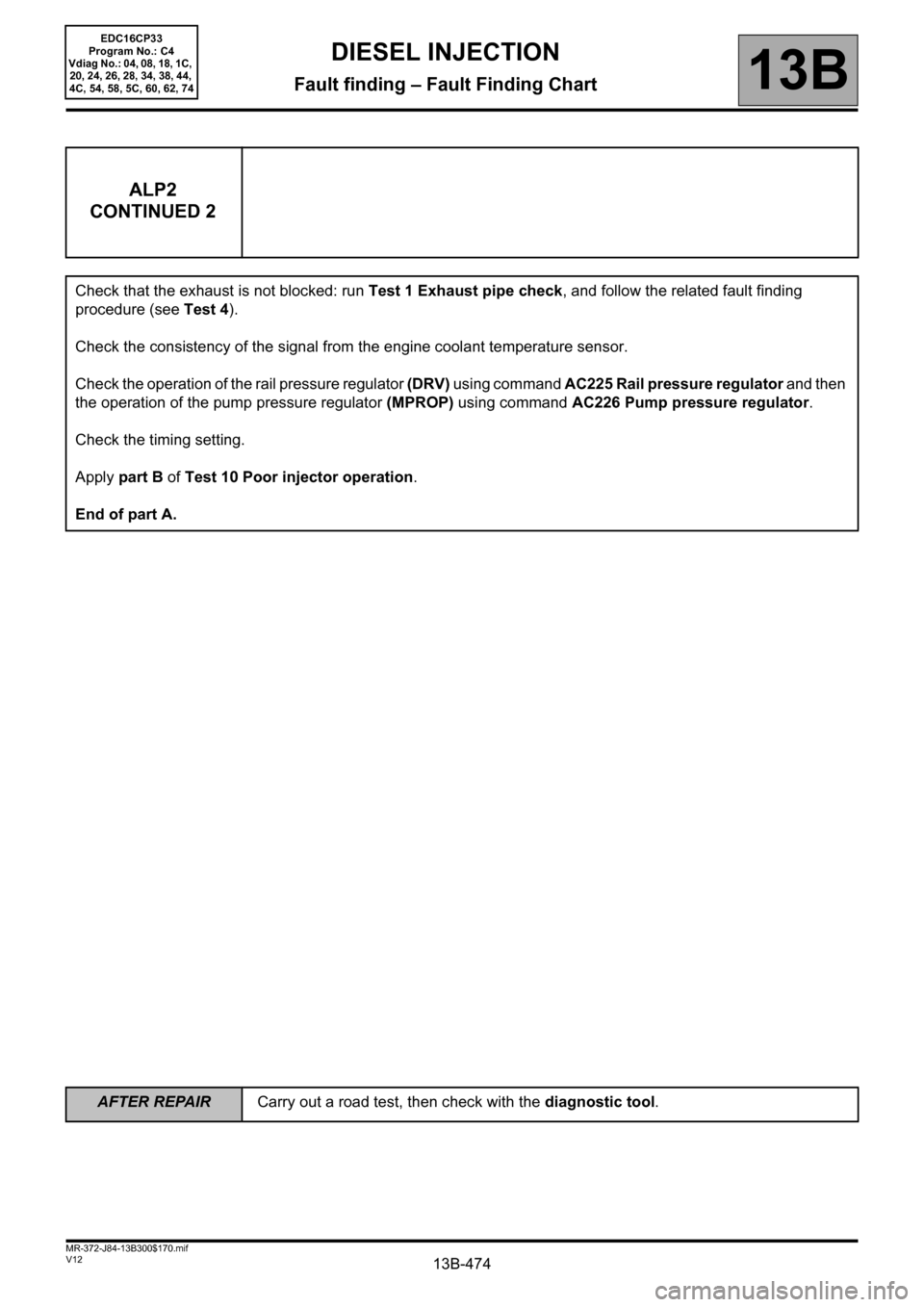
13B-474
AFTER REPAIRCarry out a road test, then check with the diagnostic tool.
V12 MR-372-J84-13B300$170.mif
DIESEL INJECTION
Fault finding – Fault Finding Chart13B
ALP2
CONTINUED 2
Check that the exhaust is not blocked: run Test 1 Exhaust pipe check, and follow the related fault finding
procedure (see Test 4).
Check the consistency of the signal from the engine coolant temperature sensor.
Check the operation of the rail pressure regulator (DRV) using command AC225 Rail pressure regulator and then
the operation of the pump pressure regulator (MPROP) using command AC226 Pump pressure regulator.
Check the timing setting.
Apply part B of Test 10 Poor injector operation.
End of part A.
EDC16CP33
Program No.: C4
Vdiag No.: 04, 08, 18, 1C,
20, 24, 26, 28, 34, 38, 44,
4C, 54, 58, 5C, 60, 62, 74
Page 478 of 510
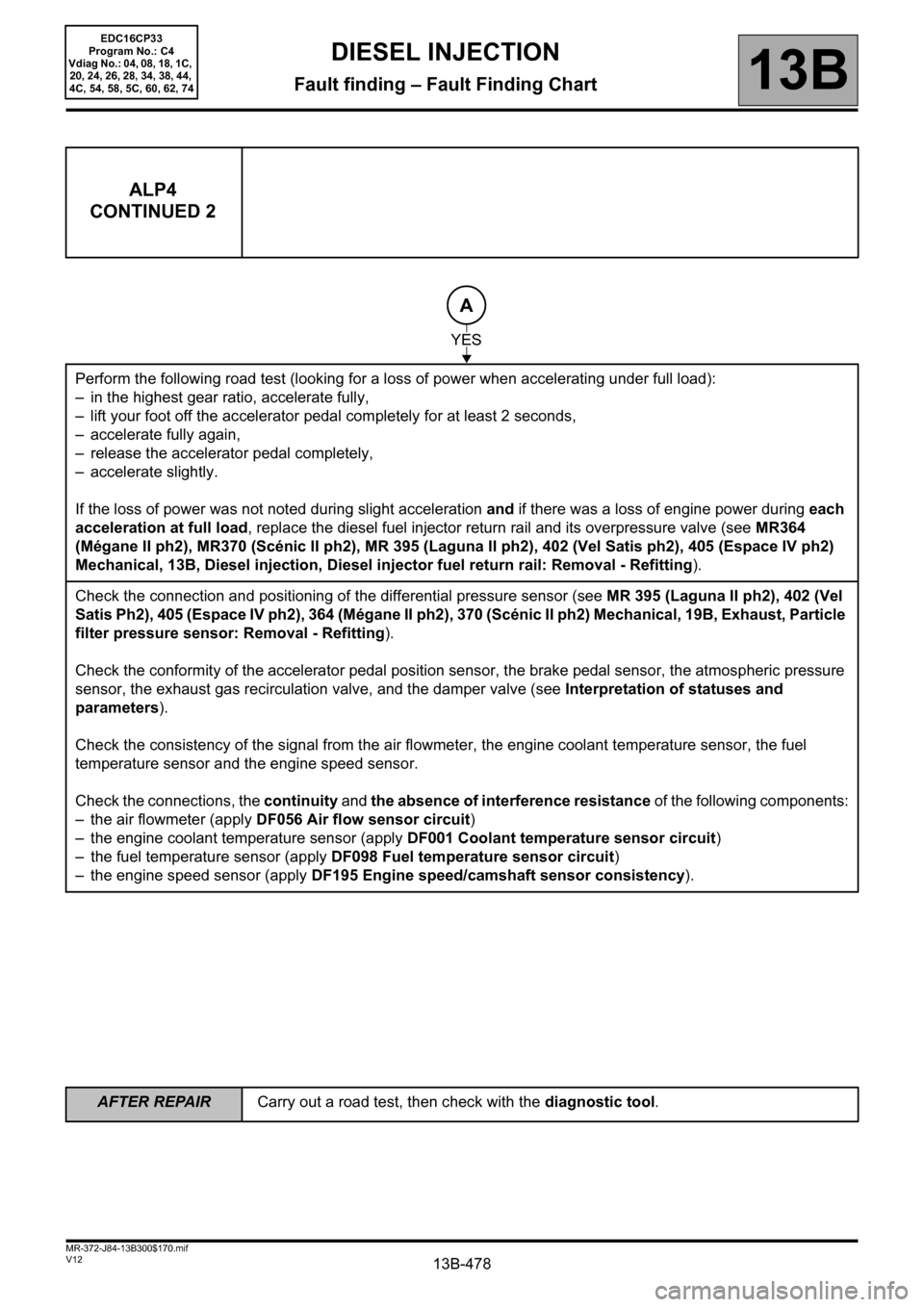
13B-478
AFTER REPAIRCarry out a road test, then check with the diagnostic tool.
V12 MR-372-J84-13B300$170.mif
DIESEL INJECTION
Fault finding – Fault Finding Chart13B
ALP4
CONTINUED 2
Perform the following road test (looking for a loss of power when accelerating under full load):
– in the highest gear ratio, accelerate fully,
– lift your foot off the accelerator pedal completely for at least 2 seconds,
– accelerate fully again,
– release the accelerator pedal completely,
– accelerate slightly.
If the loss of power was not noted during slight acceleration and if there was a loss of engine power during each
acceleration at full load, replace the diesel fuel injector return rail and its overpressure valve (see MR364
(Mégane II ph2), MR370 (Scénic II ph2), MR 395 (Laguna II ph2), 402 (Vel Satis ph2), 405 (Espace IV ph2)
Mechanical, 13B, Diesel injection, Diesel injector fuel return rail: Removal - Refitting).
Check the connection and positioning of the differential pressure sensor (see MR 395 (Laguna II ph2), 402 (Vel
Satis Ph2), 405 (Espace IV ph2), 364 (Mégane II ph2), 370 (Scénic II ph2) Mechanical, 19B, Exhaust, Particle
filter pressure sensor: Removal - Refitting).
Check the conformity of the accelerator pedal position sensor, the brake pedal sensor, the atmospheric pressure
sensor, the exhaust gas recirculation valve, and the damper valve (see Interpretation of statuses and
parameters).
Check the consistency of the signal from the air flowmeter, the engine coolant temperature sensor, the fuel
temperature sensor and the engine speed sensor.
Check the connections, the continuity and the absence of interference resistance of the following components:
– the air flowmeter (apply DF056 Air flow sensor circuit)
– the engine coolant temperature sensor (apply DF001 Coolant temperature sensor circuit)
– the fuel temperature sensor (apply DF098 Fuel temperature sensor circuit)
– the engine speed sensor (apply DF195 Engine speed/camshaft sensor consistency).
A
YES
EDC16CP33
Program No.: C4
Vdiag No.: 04, 08, 18, 1C,
20, 24, 26, 28, 34, 38, 44,
4C, 54, 58, 5C, 60, 62, 74